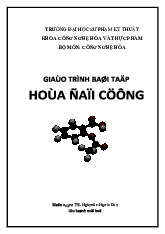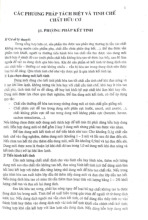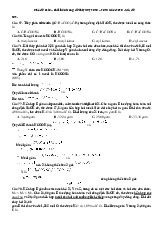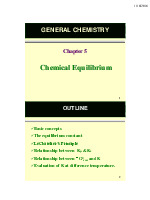



















Preview text:
lOMoAR cPSD| 58490434
GENERAL CHEMISTRY
Chapter 4 Chemical Thermodynamics
Chemical Thermodynamics
❖ In thermodynamics we study the energy changes that
accompany physical and chemical processes.
❖ In this chapter we study the two main aspects:
✓ The first is concerned with how we observe, measure, and
predict energy changes for both physical changes and chemical reactions.
✓ We will learn to use energy changes to tell whether or not a given
process can occur under specified conditions to give
predominantly products (or reactants) and how to make a process more (or less) favorable..
❖ We will consider enthalpy and entropy. lOMoAR cPSD| 58490434 Spontaneous Processes
❖ Any process that occurs without outside intervention is spontaneous.
❖ When two eggs are dropped they spontaneously break.
❖ The reverse reaction is not spontaneous.
❖ We can conclude that a spontaneous process has a direction.
Spontaneous Processes Direction
❖ A process that is spontaneous in one direction is not
spontaneous in the opposite direction.
❖ The direction of a spontaneous process can depend on
temperature: Ice turning to water is spontaneous at T >
0 C, Water turning to ice is spontaneous at T < 0 C. lOMoAR cPSD| 58490434 Class Example Problem
• Predict whether the following processes are spontaneous as
described, are spontaneous in the reverse direction, or are
in equilibrium: (a) When a piece of metal heated to 150
oC is added to water at 40 oC, the water gets hotter. (b)
Water at room temperature decomposes into H2(g) and
O2(g). (c) Benzene vapor at a pressure of 1 atm condenses
to liquid benzene at the normal boiling point of benzene, 80.1 oC. Reversible Processes
A reversible process is one that can go back and forth
between states along the same path.
❖Chemical systems in equilibrium are reversible.
✓ They can interconvert between reactants and products
✓ For example, consider the interconversion of water and ice at 0 oC.
❖There is only one reversible path between any two states of a system. lOMoAR cPSD| 58490434 Irreversible Processes
A irreversible process is one that cannot be reversed to
restored the system to its original state.
✓ To get back to the original state a different pathway must be followed.
✓ In any spontaneous process, the path between reactants and products is irreversible.
Systems and Surroundings
Analyzing Energy Changes
• System : part of the universe we are interested in.
• Surroundings : the rest of the universe. lOMoAR cPSD| 58490434 Transferring Energy
❖ Work and Heat
❖ Force is a push or pull on an object .
❖ Work is the product of force applied to an object over a distance : w F d
❖ Energy is the work done to move an object against a force .
❖ Heat is the transfer of energy between two objects .
❖ Energy is the capacity to do work or transfer heat .
The First Law of Thermodynamics
❖ First Law of Thermodynamics :
✓ The total amount of energy in the universe is constant .
✓ Or energy is neither created nor destroyed in
ordinary chemical reactions and physical changes .
✓ E = q + w, where • E = internal energy change • q = heat absorbed • w = the work done lOMoAR cPSD| 58490434
The First Law of Thermodynamics
❖ Total energy lost by a system equals the total energy gained by a system.
❖ Internal Energy : total energy of a system (kinetic + potential ).
❖ Cannot measure absolute internal energy.
❖ Change in internal energy: E E final E initial lOMoAR cPSD| 58490434 Sign Conventions lOMoAR cPSD| 58490434
Exothermic and Endothermic Processes
❖ Endothermic : absorbs heat from the surroundings .
❖ Exothermic : transfers heat to the surroundings .
✓ An endothermic reaction feels cold .
✓ An exothermic reaction feels hot .
Endothermic: thu nhiệt
Exothermic: tỏa nhiệt State Functions
• State function : depends only on the initial and final
states of system, not on how the internal energy is used . lOMoAR cPSD| 58490434 Work
❖ Chemical reactions can absorb or release heat.
❖ However, they also have the ability to do work.
❖ For example, when a gas is produced, then the produced
gas can be used to push a piston, thus doing work.
Zn(s) + 2H+(aq) Zn2+(aq) + H2(g)
❖ The work performed by the above reaction is called
pressure-volume work. ❖ When the pressure is constant, w P V lOMoAR cPSD| 58490434 Enthalpy
❖ Enthalpy, H : Heat transferred between the system and
surroundings carried out under constant pressure . H E PV
❖ Units of H : kJ/mol or kcal/mol
❖ Enthalpy is a state function .
❖ If the process occurs at constant pressure , H E PV E P V Enthalpy • Since we know that w P V • We can write H E P V q P
• When H , is positive , the system gains heat from the surroundings.
• When H , is negative , the surroundings gain heat from the system. lOMoAR cPSD| 58490434 Enthalpy
Enthalpies of Reaction • For a reaction : H H H final initial H H products reactants •
Enthalpy is an extensive property (m agnitude H is
directly proportional to amount) : CH CO
4 ( g ) + 2 O 2 ( g )
2 ( g ) + 2 H 2 O( g ) H = - 802 kJ 2 CH 2
4 ( g ) + 4 O 2 ( g )
CO 2 ( g ) + 4 H 2 O( g ) H = 1604 kJ lOMoAR cPSD| 58490434
Enthalpies of Reaction
• When we reverse a reaction , we change the sign of H : CO ) CH 802
2 ( g + 2H 2 O( g )
4 ( g ) + 2O 2 ( g ) H = + kJ
• Change in enthalpy depends on state: H H 2 O( g )
2 O( l ) H = - 88 kJ Hess’s Law
• Hess’s law : if a reaction is carried out in a number of
steps, H for the overall reaction is the sum of H for each individual step. • For example : CH ) CO
4 ( g + 2O 2 ( g )
2 ( g ) + 2H 2 O( g ) H = - 802 kJ 2 H 2H 88 2 O( g ) 2 O( l ) H = - kJ CH ) CO )
4 ( g + 2O 2 ( g )
2 ( g + 2H 2 O( l )
H = ??? kJ lOMoAR cPSD| 58490434 Hess’s Law H 1 H 2 Reactance H Products H 5 H 3 H 4 H =
H + H = H + H + H 1 2 3 4 5 Hess’s Law Note that : H = + 1 H 2 H 3 lOMoAR cPSD| 58490434 Hess’s Law CH 4 ( ) g C + H ( ) s 2 H 2 ( ) g 1 C ( s ) + O 2 ( ) g CO H 2 (g ) 2 2 H 2 ( ) g + O 2 ( ) g 2 H H 2 O ( l ) 3
--------------------------------------------- CH 4 ( ) g + 2 O 2 ( ) g CO + H=? 2 g ( ) 2 H 2 O l() , H H H H = 1 + 2 + 3 Hess’s Law
Use the thermochemical equations shown here to
determine enthalpy,
H 0 298 , for the following
reaction : C ( graphite ) + ½O ( ( 2 ( g ) → CO g), 1 ) = ? H 0 298 C( graphit ) + O ( 2 ( g ) → CO 2 g
), H 0 298 = - 393 , 5 kJ ( 2 )
CO(g) + ½O 2 ( g ) → CO 2 ( g), H 0 298 = - 283 , 0 kJ ( 3 ) Sol :
→ H 0 298 tt CO(g) = - 393 , 5 - ( - 283 , 0 ) = - 110 , 5 kJ/mol lOMoAR cPSD| 58490434 lOMoAR cPSD| 58490434
Enthalpies of Formation
• The standard molar enthalpy of formation, H of, of a
substance is the enthalpy change for the reaction in
which one mole of the substance in a specified state
is formed from its elements in their standard states.
• Standard conditions (standard state): 1 atm and 25 oC (298 K).
• Standard enthalpy, Ho, is the enthalpy measured when
everything is in its standard state. lOMoAR cPSD| 58490434
Enthalpies of Formation
• If there is more than one state for a substance under
standard conditions , the more stable one is used . • o The H value f
for any element in its standard state is zero .
Standard Enthalpies of Formation at 298 K lOMoAR cPSD| 58490434
Using Enthalpies of Formation to
Calculate Enthalpies of Reaction
• We use Hess’ Law to calculate enthalpies of a reaction from enthalpies of formation. • For a reaction H n H products m reactants rxn f H f lOMoAR cPSD| 58490434 lOMoAR cPSD| 58490434 Heat of Combustion
❖ The heat of combustion (ΔH 0
c ) is the energy released as heat
when one mole of a compound undergoes complete combustion
with oxygen. The chemical reaction is typically a hydrocarbon
reacting with oxygen to form carbon dioxide, water and heat.
❖ Standard Enthalpy of Combustion: ΔH0c,298.
❖ Standard enthalpy of combustion is defined as the enthalpy change
when 1 mole of a compound is completely burnt in oxygen gas at 298K and 1 bar pressure. ❖ Examples:
C8H18(l) + 12½O2(g) → 8CO2(g) + 9H2O(l), ΔH0c,298 = -5512kJ.mol-1
C6H12O6(s) + 6O2(g) → 6CO2(g) + 6H2O(l), ΔH0c,298 = -2816kJ.mol-1
Heat of Combustion for some common fuels Fuel kJ/g kcal/g BTU/lb Hydrogen 141.9 33.9 61,000 Gasoline 47.0 11.3 20,000 Diesel 45.0 10.7 19,300 Ethanol 29.8 7.1 12,000 Propane 49.9 11.9 21,000 Butane 49.2 11.8 21,200 Wood 15.0 3.6 6,000 Coal (Lignite) 15.0 4.4 8,000 Coal (Anthracite) 27.0 7.8 14,000 Natural Gas 54.0 13.0 23,000



